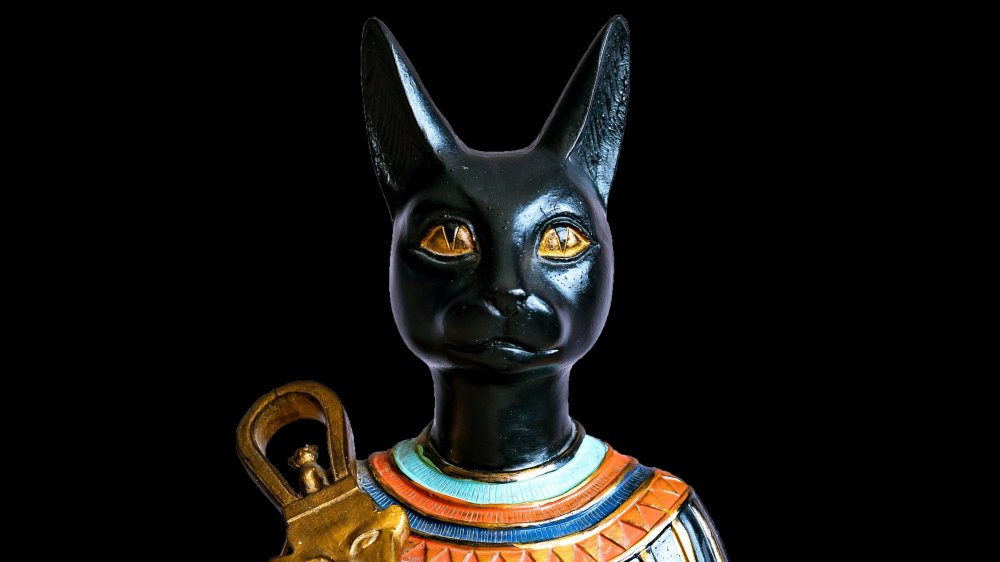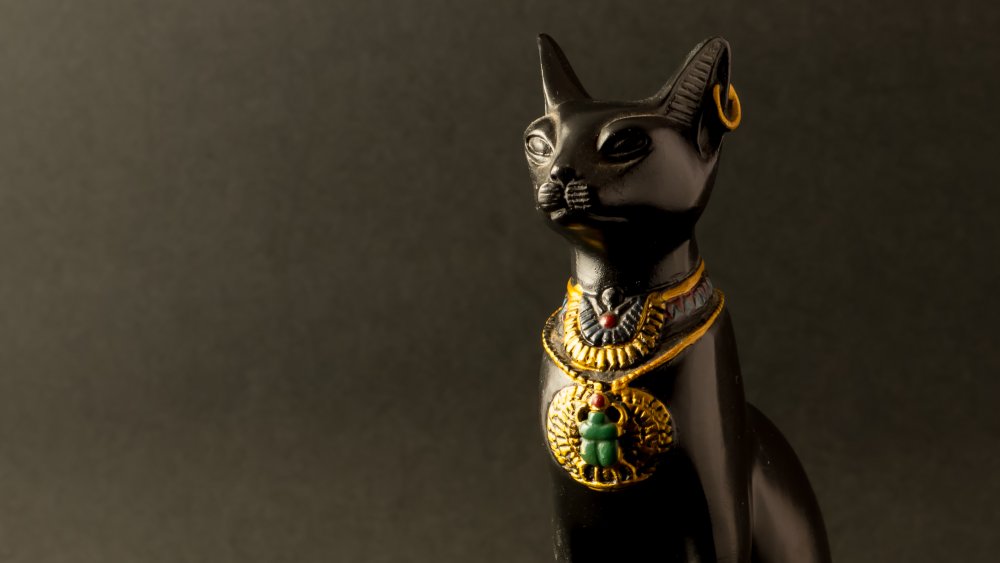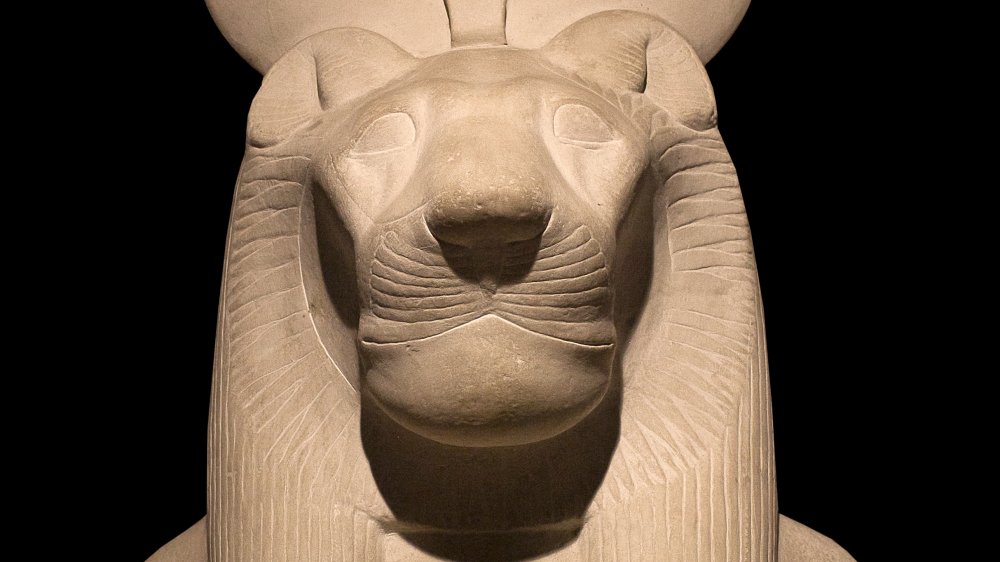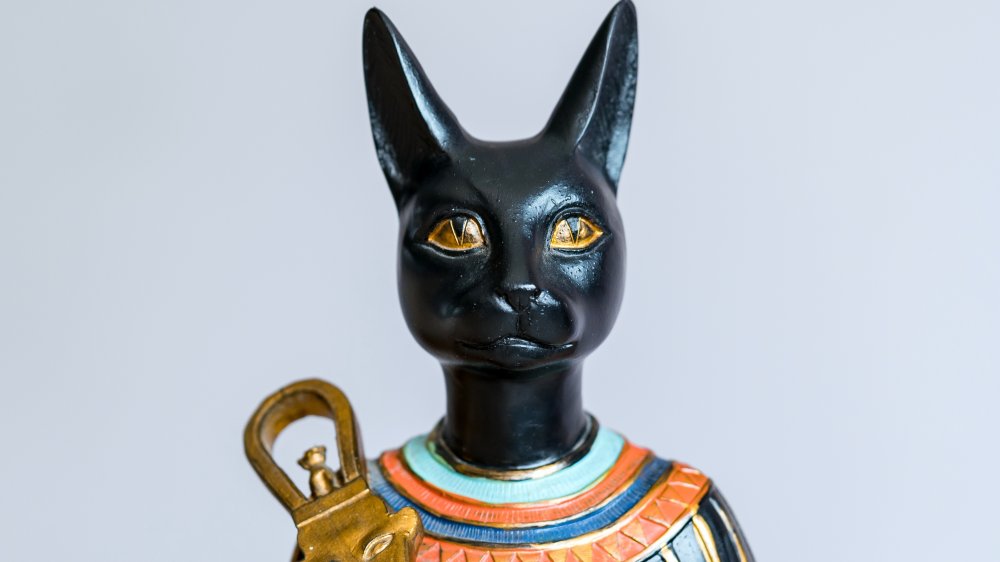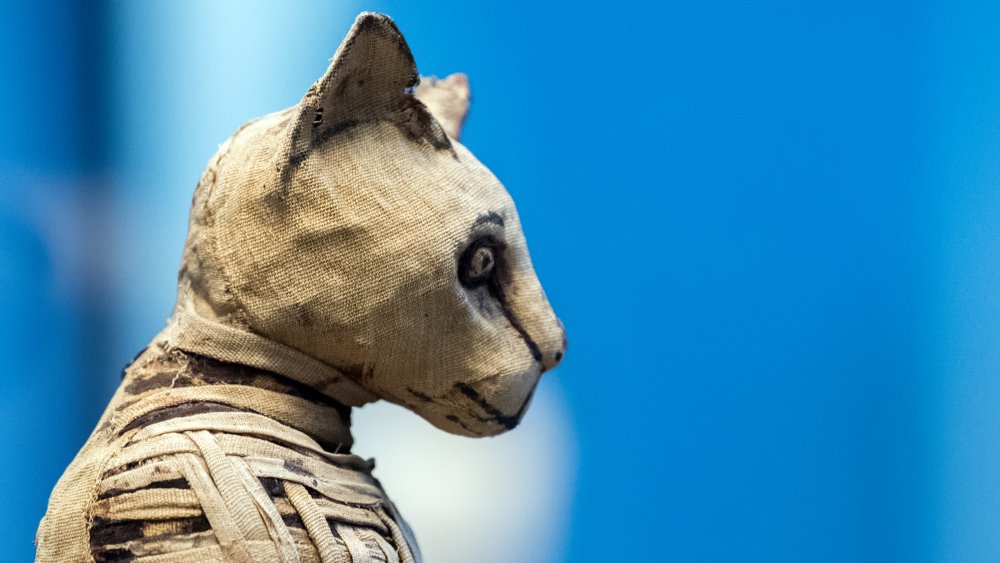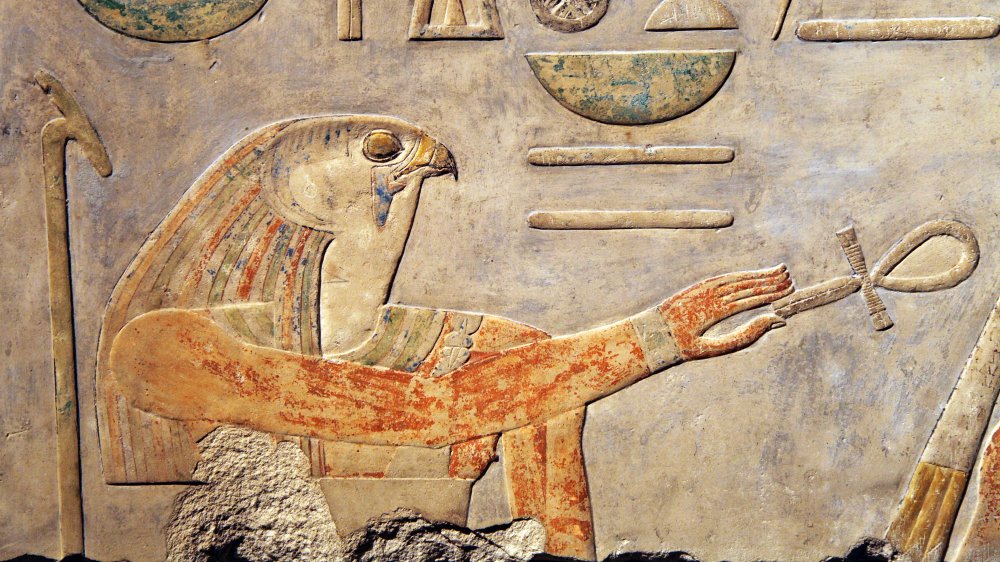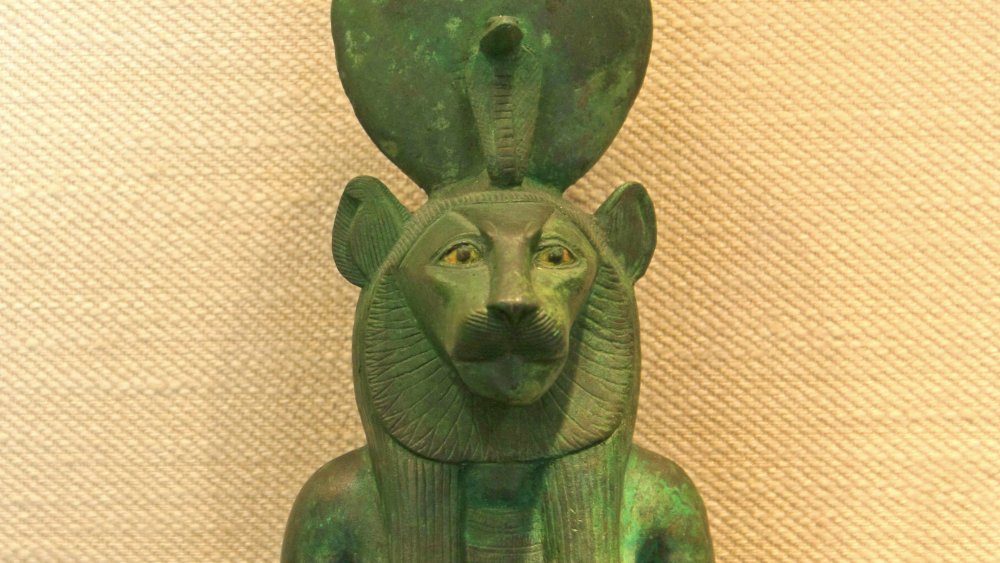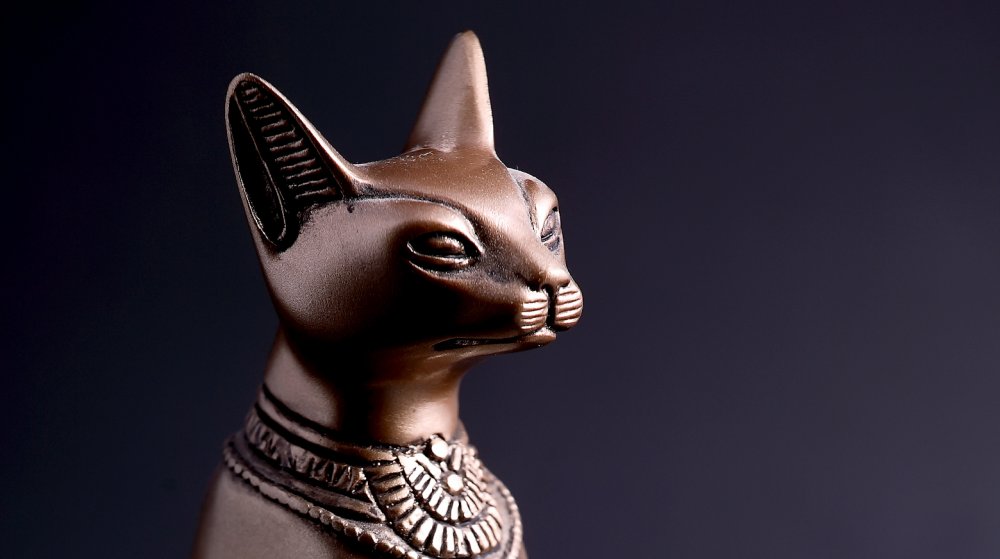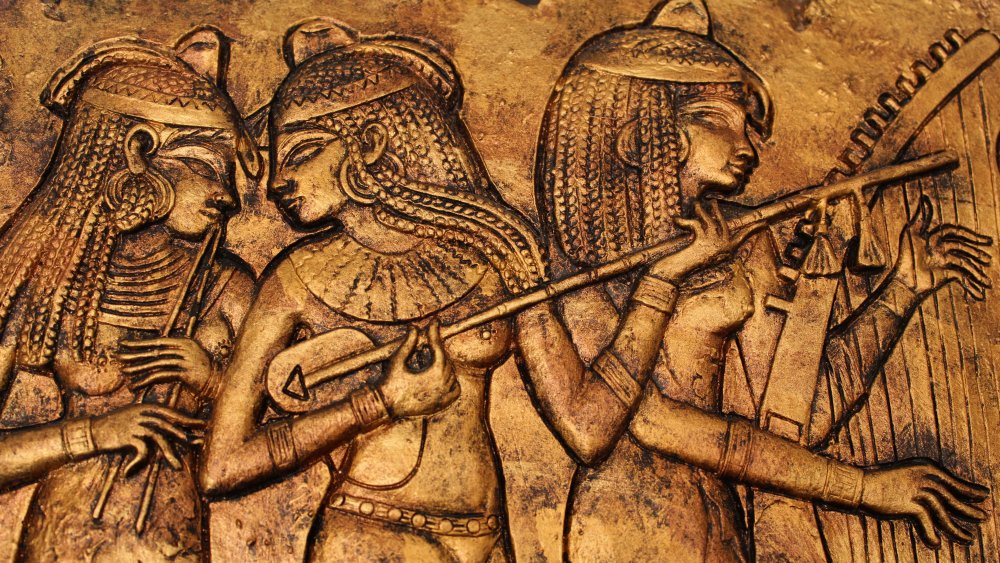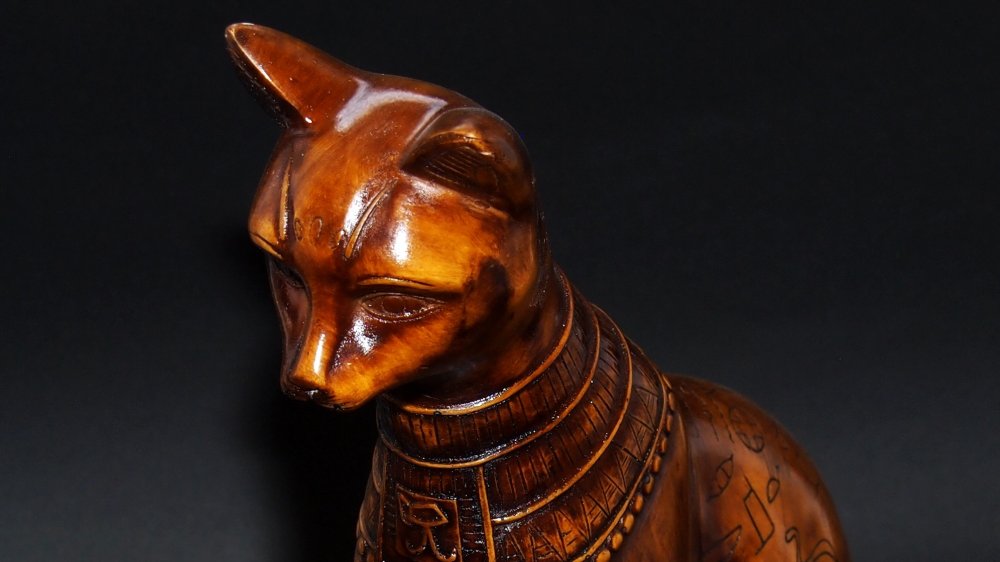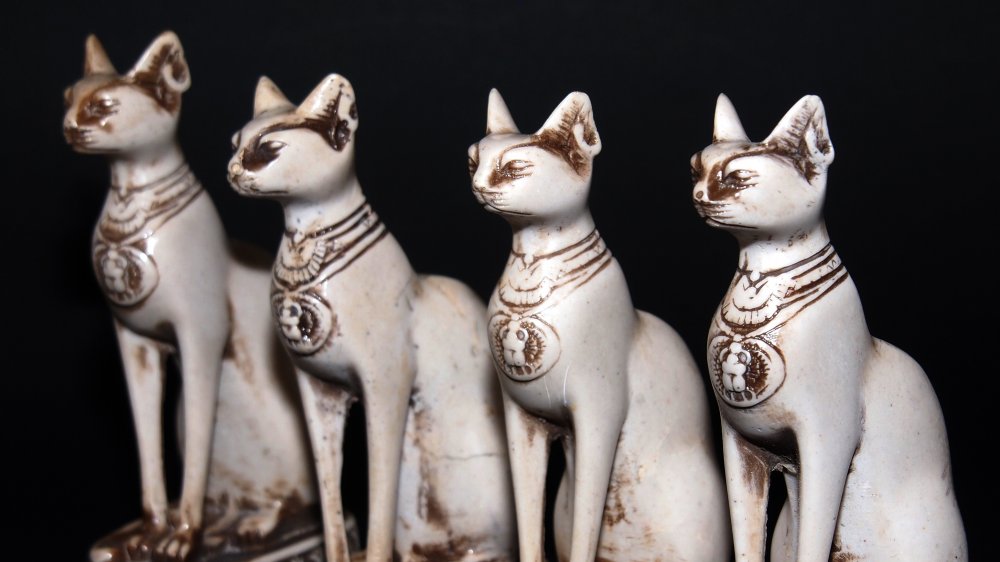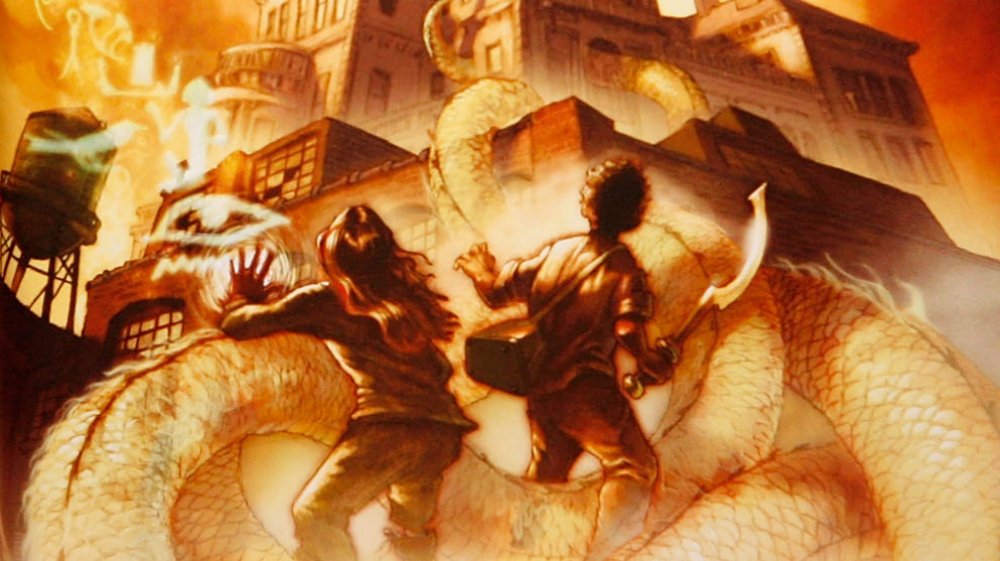Bastet: A Guide To The Egyptian Cat Goddess
If you've ever looked into Egyptian mythology, you've likely come across Bastet, sometimes called Bast. Bastet is most commonly known as the cat goddess, as she is often depicted with the head of a house cat. However, her feline form is only one of her many intriguing aspects. Bastet was known for her gentleness as the protector of women and the home. Yet she could also be ferocious when punishing those who harmed others and created disorder in society. She was prominently featured in myths and was considered one of the most powerful figures in the ancient Egyptian pantheon. Due to her immense popularity, she was often depicted in Egyptian art. She was also the subject of a riotous festival that attracted thousands of worshippers to the ancient city of Bubastis every year.
Are your ears perking up? Are you just scratching for more information? If so, read on for a primer on this most fascinating deity.
Bastet had many names
Over the years, Bastet has been called by a multitude of names. According to the Ancient History Encyclopedia, the Egyptians originally referred to her as "B'sst." Then she was known as "Ubaste." Eventually, this was shortened to "Bast," and then "Bast" was lengthened to "Bastet." Scholars haven't come to a definitive conclusion about the significance of the goddess' name. However, American Egyptologist Geraldine Pinch believes that it likely means "She of the Ointment Jar." This theory makes sense, considering that Bastet was often associated with protective ointments as well as with Nefertum, the god of perfume and sweet smells.
The Egyptians had a variety of epithets for Bastet. The Ancient History Encylopedia mentions "Lady of Dread" and "Lady of Slaughter," while the Rosicrucian Egyptian Museum lists a significantly less frightening assortment: "Lady of the East," "Goddess of the Rising Sun," "Goddess of the Moon," and "Sacred and All-Seeing Eye."
The Greeks had a special title for Bastet, too: "Soul of Isis." How did this name come about? The Greeks associated Bastet with their warrior goddess Artemis, who had a twin brother, Apollo. Consequently, they believed that Bastet must also have a twin brother, as well, and decided that Horus, son of the Egyptian goddess Isis, was the most likely candidate. Therefore, they sometimes referred to Bastet as "Bast ba'Aset," or "Soul of Isis" when translated literally.
Bastet was typically depicted in feline form
The Ancient History Encylopedia states that Bastet was originally known to her followers as a lioness or lion-headed woman. In this form, she was considered to be a fierce protector of those who lived in harmony with each other, and a bloodthirsty punisher of those who broke sacred laws and sowed destruction. Her ferocious demeanor was feared by all those who worshipped her.
Bastet's appearance slowly shifted over time. Eventually, she came to be seen as a domestic cat, more of a gentle companion than a dangerous and unpredictable force. Artistic depictions showed her as a reclining house cat or a woman with the head of a cat. Sculptors gradually erased all traces of her former viciousness and took to portraying her with a mild, pensive expression. However, it is important to note that even as her image softened, the ancient Egyptians continued to see her as a minister of justice who showed no mercy to the cruel.
Bastet was known as a protector of women
The Ancient History Encyclopedia explains that Bastet was the patron of women in a special way. As the goddess of fertility and childbirth, she was particularly associated with mothers. She also warded off diseases associated with women and children and was said to guard women's secrets.
Women were granted a good deal of power and respect in ancient Egyptian society: They were seen as valuable members of the family and possessed considerable legal rights. The need for a goddess who was particularly concerned with women's interests and health was recognized by all Egyptians, regardless of gender. Thus, Bastet was one of the most popular deities in the Egyptian pantheon. Both men and women prayed to her, served as her clergy, brought her sacrifices, and reveled in her name at her annual festival.
According to the Johns Hopkins Archaeological Museum, it was common for women to make amulets dedicated to Bast. Typically, these amulets were intended to "[harness] her fecundity and protection."
Bastet was also venerated as a protector of the household
Bastet was not only the protector of women. The Ancient History Encyclopedia notes that she was also the deity of the domestic sphere, bringing safety, happiness, and health to the homes of her devotees. This role was inextricably bound up with her identity as a cat goddess.
In his article "The Cat and Ancient Egypt," American Egyptologist Frank J. Yurco explains that the ancient Egyptians appreciated the domestic cat for myriad reasons. It was able to provide loving companionship as a pet. Additionally, it could kill mice, serpents, and other vermin with ease, making it especially instrumental in protecting crops and mitigating the spread of disease. As a cat goddess, Bastet was similarly able to provide solace and protection to her followers. She could serve as a benevolent spiritual companion, watching over them as they went about their day-to-day activities. She could also defend their homes against all manner of threats.
Bastet was the daughter of Ra, the sun god
Bastet was one of the most powerful deities in the Egyptian pantheon. Thus, it is no wonder that her father was Ra, king of the gods. The Routledge Dictionary of Egyptian Gods and Goddesses, written by British Egyptologist George Hart, describes Ra as a celestial ruler who typically manifested as "a falcon wearing the fiery disk of the sun on its head." He sprang from a "primordial lotus flower" at the beginning of time and created the world with his tears. He also invented the seasons and the annual flooding of the Nile River.
According to the Rosicrucian Egyptian Museum, Bastet had an especially close bond with Ra. Every day, she would ride beside him in his flying boat as he ferried the sun across the sky. In her cat form, she would watch over him at night to protect him from Apep, the Egyptian embodiment of chaos and his greatest enemy. In her book Egyptian Mythology: A Guide to the Gods, Goddesses, and Traditions of Ancient Egypt, Geraldine Pinch recounts another myth involving Ra and Bastet: Apparently, the sun god once healed her after she ingested poison, demonstrating the mutual relationship of care between the two.
Bastet was the mother of Maahes, a lion god
Bastet's lineage was just as great as her ancestry. According to Ancient Egypt Online, she was the mother of the fearsome god Maahes. Maahes went by several names, including Mihos and Mysis. Yet he was mainly known by his many imposing epithets, which included "Lord of the Massacre," "Wielder of the Knife," "The Scarlet Lord," and "Lord of Slaughter." Despite what these titles might suggest, Maahes was not seen as evil. Much like his mother, he was merely a force of justice, punishing those who dared to defy divine laws.
Maahes had many other aspects in common with Bastet, as well. He often took on a feline form, preferring to appear as a lion or lion-headed man. He was also considered a patron of pharaohs and a protector of the innocent, just as she was. Sometimes, he was venerated alongside her. However, he was primarily worshipped in his own right in the aptly named "Leontopolis," or "city of lions," where his temple was located.
In addition to being associated with cats, Maahes was considered the personification of the sun's heat. This makes sense, given that his grandfather was Ra, the all-powerful sun god himself.
Bastet's cult was centered in the city of Bubastis
The Ancient History Encyclopedia states that Bastet's cult was centered in the city of Bubastis from the fifth century BC. Her followers traveled there from far and wide to pay their respects to her, often by having their cats interred as a dedication to her. Their patronage made Bubastis one of Egypt's wealthiest and most prosperous cities.
Herodotus, a Greek historian who lived during the fifth century BC, described Bastet's temple as a place of great beauty and grandeur. "The temple is in the midst of the city, the whole circuit of which commands a view down into it. [...] A stone wall, carven with figures, runs round it; within is a grove of very tall trees growing round a great shrine, wherein is the image of the goddess," he wrote. "A road, paved with stone, of about three furlongs' length leads to the entrance, running eastward through the market place [...] This road is about 400 feet wide, and bordered by trees reaching to heaven." However, the building was more than just a house of worship. Egyptians could visit it to receive medical attention, counseling, and food, making it one of the most important locales in the city.
A large festival was held in Bastet's honor
Bubastis was especially popular with devotees of Bastet during its annual festival in the deity's honor. The American Research Center in Egypt explains that Herodotus wrote about this event at great length. According to the historian, it was typical for men and women to sail to the festival together in crowded boats. During the voyage, the pilgrims would shake "rattles," "play the flute," and "sing and clap their hands." Whenever they passed a major city, they would bring the boat to shore. Then they would dance and call out to any onlookers, presumably to entice them to join their party. Upon reaching Bubastis, they would continue their revelry.
According to the Ancient History Encyclopedia, many attendees of the festival would deliver their mummified cats to Bastet's temple. They would also drink alcohol, dance, play instruments, and display their genitals. Some scholars infer that this behavior reflected a joyful defiance of societal constraints. Others hold that it was related to Bastet's status as a fertility goddess. The American Research Center in Egypt believes a text called "The Mythos of the Eye of Ra" might provide some additional insight. In this story, Bastet is furious with Ra for an unexplained reason. Ra sends Thoth, his godly messenger, to calm her, which he does by playing music for her, dancing for her, and offering her alcohol. It is possible that Bastet's worshippers used this tale as a guide for how to please the goddess.
Bastet was associated with The Tale of Setna and Taboubu
According to the Ancient History Encyclopedia, one of the most well-known myths about Bastet is "The Tale of Setna and Taboubu." In this story, Prince Setna disobeys orders by stealing a book from a tomb. After committing this crime — and seemingly getting away with it — he visits the city of Memphis. While he is going for a stroll, a beautiful woman catches his eye. Overcome with lust, he asks for her name and learns that she is Taboubu, the daughter of a priest of Bastet.
Setna sends Taboubu a letter, asking if she will sleep with him in exchange for gold. Taboubu responds by telling Setna to come to her home instead. There, Taboubu tells Setna that she will sleep with him if he grants her ownership of all his possessions — and agrees to have his children killed. Blinded by his attraction, Setna agrees and embraces her. When he touches her, however, she vanishes, and he finds himself standing naked in the street. The pharaoh arrives to explain that his children are still alive, and the previous events were merely his punishment for stealing the book. Setna then makes restitution to the family who owns the tomb, having learned his lesson.
Some scholars believe that Taboubu is an analogue for Bastet herself. In this case, the myth could represent her role as a divine minister of justice. It could also communicate a message about respecting women rather than objectifying them.
Bastet was a protector of pharaohs
As their name suggests, The Pyramid Texts were a series of writings carved into the walls of various pyramids in Saqqara circa 2400 BC. In these texts, according to the Ancient History Encylopedia, Bastet was portrayed as having a special significance to the king of Egypt. She was depicted as his nursemaid in his youth and as his protector in his adulthood.
Bastet is one of the most powerful goddesses in the Egyptian pantheon. She is strong both mentally and physically, with all the cleverness and ferocity that cats are known for. Therefore, it makes sense that numerous pharaohs have been associated with her. According to an essay by Egyptology scholar S.D. Cass, Khaefre appeared beside her in sculpture, while Amenemhet III sang, "Bast is she who protects the lands" in one of his hymns. Many other pharaohs were linked to her through their titles. Shepsekaf was known as the "Beloved of Het-hert-Bast." Senwosret I, II, and III all shared a name that literally translated to "Son of the Strong Lady" — that lady being Bastet, of course. Seti I and Osorkon II were also both known as "Son of Bast."
Bastet was often depicted in sculpture
Ancient Egyptians often sculpted statuettes of Bastet to demonstrate their devotion to her. According to the Louvre, these statuettes were brought to her temples as offerings. Sometimes they were intended to thank the goddess for her blessings. Other times, they were meant to invoke her presence so that she could grant a favor.
Artisans commonly depicted Bastet holding a musical instrument called a sistrum and a protective adornment called an aegis. The sistrum "was composed of a neck topped by a long arch to which three stems strung with small metal disks were attached." Shaking it was known to soothe the goddess so that she would be more willing to communicate with whomever was calling upon her. The aegis typically took the form of "a collar-like necklace." The one worn by the statuette of Bastet in the Louvre's collection depicts "the head of a lioness crowned by the sun disk," indicating Bastet's status as the daughter of Ra.
Although the image of Bastet as a cat-headed woman standing upright was favored by sculptors, they also represented her in other forms. Many statuettes of Bastet depict her as a seated domestic cat. Others show her surrounded by kittens, emphasizing her connection to childbirth and fertility.
Bastet has been depicted in novels and comic books
S.D. Cass claims that no modern temples of Bastet exist today. However, the goddess' legacy has been preserved through various creative works. One such text is the novel Thomasina, The Cat Who Thought She Was God, written by Paul Gallico in 1957. The New York Journal of Books explains that it is partially narrated by a cat named Thomasina, who believes that she is not a mere house cat but Bastet in disguise. She introduces herself by proclaiming, "My name is Bast-Ra. I am the Cat Goddess of Bubastis. My other titles are 'Lady of the East' and 'Lady of the Sept,' the star in the eastern Heavens. [...] I am a most important and powerful deity."
Bastet was later featured in several releases by DC Comics. She had a prominent role in Neil Gaiman's Sandman series. According to ReadDC.com, she even received her own spin-off trilogy called The Sandman Presents: Bast, which focuses on her strange friendship with a teenage girl named Lucy. DC Comics News reports that she was also featured in a series called Doctor Fate, which tells the story of a medical school student who is chosen by the Egyptian gods to preserve the fate of mankind.
Additionally, Bastet is a supporting character in Rick Riordan's The Kane Chronicles, a trilogy about two teenagers (pictured above) who encounter the Egyptian gods. According to Riordan's website, his books' version of the goddess uses a house cat named Muffin as her host.
